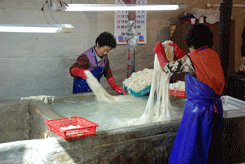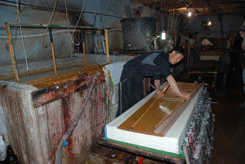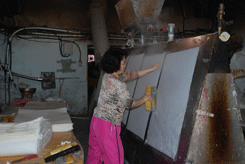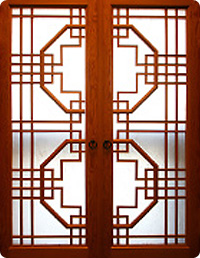Hanji
 |
 |
 |
Hanji
Traditional handmade paper was an indispensable material of daily life in Korea. The versatile use of paper can be easily seen in Korean culture throughout its history. Traditional handmade Korean paper was used for calligraphy, books, and envelopes; for doors, walls, and windows; for furniture, such as wardrobes, cabinets, and chests; for craft objects, such as writing brush holders, umbrellas, lanterns, boxes, baskets, fans, and kites; and for clothing and shoes. Koreans seem to be the only people who have been using paper for their floors.
Since Korea was opened to the Western world, many traditions have declined, including traditional papermaking. There are still a few papermakers producing papers in the traditional way in Korea, but it has been difficult for them to earn a living because the traditional way of papermaking is so laborious and the market is limited.
The history of papermaking in Korea
The origin of papermaking in Korea is not known as no written records have been handed down. However, papermaking skill must have spread from China to neighboring countries at an early stage. Some domestic and foreign scholars hypothesize that papermaking might have existed in Korea as early as the third century or at least before the end of the 6th century.
The Era of the Three Kingdoms (1st century BC - 7th century AD)
It is believed that the kingdom of Goguryeo started to record its history from the beginning of its era and left Yugi, 100 volumes of written history. The kingdom of Baekje compiled its history at the end of the 4th century and Silla did the same in the middle of the 6th century.
There are no records of papermaking during this era, but it can be presumed that by that time traditional papermaking skills were well developed; otherwise it would have been impossible to supply the large amount of paper needed to satisfy the demands of writing so many history books. The earliest known extant printed Buddhist text, Dharani Sutra, was found at the Bulguk Temple in Gyeongju, which was the capital of Silla. It was inside a stupa sealed in 751. Moreover it was found with a record that had the exact date when this project was started, and the papermaker’s name. During its conservation, it was confirmed that the paper had been made of paper mulberry.
The Goryeo Kingdom (918 - 1392)
During this period, the publishing of all kinds of books flourished, including Buddhist texts, medical and history books. Paper money was also issued. It was the golden age of papermaking and publishing, especially during the 11th and 12th centuries. As a result, the demand for paper increased and the Goryeo government exhorted farmers to cultivate paper mulberry throughout the country from 1145 on, and also encouraged people to make paper.
Goryeoji, the paper made in Goryeo, was frequently mentioned in literature and history books in China as Goryeoji gained fame among scholars and emperors due to its excellent quality.
Having Buddhism as the state religion, the Goryeo government sponsored many Buddhist activities. One of its important achievements was the publication of the Tripitaka, the Buddhist sutras and commentaries, despite being at war with the Mongol empire in the 13th century. The total number of woodblocks for one set of the sutras came to 86,686, and 162,890 sheets of paper were needed for printing the Korean edition of the Tripitaka. It was also during this period that the first movable metal typeface was invented in Goryeo. Although the exact date of the invention is difficult to identify, many scholars speculate that it was more than 78 years before Gutenberg used movable type in the 15th century. The earliest text printed was Jikjisimcheyojeol done in 1377.
The Joseon Kingdom (1392 - 1910)
The Joseon kingdom that replaced the Goryeo kingdom, was a neo-Confucian state. During its approximately 500 years, many literary and philosophy books were published. From the beginning of this kingdom, there was an effort to revive papermaking skills by establishing a papermaking department operated by the government. However, because of the increasing popularity of publishing a wide range of books, there was a lack of material. The Joseon government sent papermakers to China to learn their papermaking methods using different raw materials and also imported materials from Japan; in 1430 King Sejong sent an envoy to Daema Island to get fine Japanese mulberry for cultivation. A wide range of different raw materials, such as pine tree bark, rice straw, and bamboo, were used for papermaking. Although this was not the first time that other materials had been mixed with paper mulberry, such mixtures became more common from this period on. The peaceful era of the early Joseon culture ended in 1592 when the Japanese invaded after Japan was newly-unified under Hideyoshi Toyotomi. During the seven years of war, Hideyoshi and his generals pillaged the Joseon cultural properties, and many craftsmen were taken as slaves and transported to Japan. The papermaking industry was greatly damaged by this invasion since it was based on the labor of farmers in the agricultural off season. After this war the government pressured Buddhist monasteries to supply paper as monks were already producing papers for religious texts. At the same time, a heavy tribute of paper was demanded by China during the Yuan, Ming, and Ching dynasties. All these factors exhausted the papermaking industry, and the quality of paper produced in this period declined. It was near the end of this period when western paper equipment was brought to Korea from Japan by a Korean government official in 1884.
The Korean papermaking process
There is not much written information on how the traditional papermaking process has varied over time, but the principles employed seem to be much the same. One-year-old dac (Korean term for paper mulberry, Broussonetia kazinoki or Broussonetia Papyrifera) is usually harvested between November and February when the fibers of the inner bark are well formed and the moisture content of the bark is sufficient to make it easier to peel. When dac is cut, the diagonal cross section should face toward the south since it is believed that will help dac sprout well the next year. The steaming process makes it easy to remove the skin of the harvested dac. Two connected, gourd shaped pits are dug in a field in the shape of a gourd. In the bottom of the smaller pit, bunches of firewood are piled and small stones are put on top of them. The larger pit is filled with the harvested dac, which is laid one on top of another and then covered with branches of pine and the pit is sealed with soil. After that the firewood in the smaller pit is lit. By the time the wood is almost burned, the stones become very hot. Then the smaller pit is covered with soil and the fire extinguished with water.
The heat of the stones turns the water to steam, which moves quickly through the connection to the larger pit. This will cook the dac and soften it.
Next the outer bark is removed. The outer bark is made up of three layers - the brown outmost layer, the middle green layer, and the inner whitish layer. The softened outer bark is removed by hand; the bottom part of the branch is grabbed with one hand and the outer bark is peeled off in strips with the other hand. The removed outer bark is called jopi or pidac, and the outer bark with the top layer removed is called nokpi (nok means green). The innermost layer of the outer bark is called baekpi.
Then the jopi is soaked in a stream for about ten hours, and the brown outmost layer and the green middle layer are peeled off with a knife to obtain the white inner bark.
At this stage, it is very important not to leave any dark spots, such as are formed near nodes or from damaged bark.
In order to obtain lye for cooking fiber, traditionally the stems of plants, such as soybeans and chili or the husks of buckwheat, are burned. A big pot with holes in its bottom has a piece of fabric placed in it. Then the ashes are put into the pot and warm water is poured over it. The cloth acts as a strainer to gain a clear liquid form of alkali. The liquid is collected and its initial pH is approximately 10 to 12. Sometimes lime is also used along with wood ash. Nowadays soda ash (sodium carbonate, Na2CO3) or caustic soda (sodium hydroxide, NaOH) replaces potash from wood ash.
The white inner bark is soaked for a day again, and then roughly cut with a sickle to prevent its getting entangled during cooking. Then it is put into a big pot with the prepared alkali and boiled for 4 - 6 hours. Then the cooked fiber is put into a stream for half a day to remove the excess lye and substances dissolved in the lye. During rinsing it is also bleached by sunlight.
It is turned regularly for even bleaching. This takes about five days with lots of sunshine. After this process any dark spots are removed by hand once again. The bleached fiber is taken from the water and squeezed. It is put on a flat stone and pounded with a wooden club until it is well spread out and softened. The beaten fiber is called dacjuc. The prepared dacjuc is put into a rectangular wooden container filled with water, and it is stirred with a bamboo stick and mixed thoroughly to break up the floccules of pulp. After that, dacpul, a mucilaginous starch extracted from the root of Hibiscus manihot L., is added to help the fibers disperse evenly and prevent them from sinking in the water during the sheet formation process. Too much dacpul will delay drainage and the sheet will become very thin, whereas too little dacpul will bring faster drainage and accordingly the sheet will be very thick.
The traditional way of sheet formation is called hwabaldugi and it is one of the features that differentiates the Korean papermaking technique from other Asian methods. The papermaking screen rests upon the mould frame. During the process the craftsman holds the screen and the mould together. The far side of the mould is attached to a string hung from above. The craftsman scoops the vat stock from his side first and he lets it flow towards the far side by slanting the mould. This first scoop forms the ground of the sheet. The second scoop is taken laterally from either side and it flows away to the opposite side by slanting the mould. This is repeated until the desired thickness is achieved. Unlike a Japanese mould, there is no deckle on top of the screen to contain the stock, after dipping there is only enough time to allow a change of direction before the stock discharges off the opposite side. As a result the sheet formation process should be done quickly and this technique requires experience and skill to master. Due to this method, the paper on the craftsman’s side is usually thicker and gradually gets thinner toward the far side.
When a sheet is formed, the screen is taken from the mould frame. The screen is turned over and put on a prepared flat place. A round wooden log is lightly rolled over the screen to squeeze excess water from the sheet and then the screen is carefully lifted in a rolling motion, leaving the newly formed sheet of paper smooth and unwrinkled. The paper formed in this way is called ilhabji, meaning one-ply paper. As one side of the paper is slightly thicker than the other, in order to achieve an even thickness throughout a sheet, during the couching the papers are piled in such a way that one sheet is laid down and the next is put on top from the opposite direction. These two sheets make one piece of paper called ihabji, meaning two-ply paper. The sheets of paper are stacked in a pile, but each completed two-ply paper is marked with a thread to make it easy to separate them later. For drainage the stack of sheets is covered with a thick board and weighted with stones overnight. Later the sheets are separated and put on wooden boards for drying in the sun. These days steam heated stainless steel dryers are generally used for drying.
Finally, every ten dried sheets are piled up and overlapped with one damp sheet until about one hundred sheets are piled together.
Then the stack is covered with a thick wooden board and weighted with stones. It is left for a day to allow the moisture to spread evenly throughout the whole stack. The stack is uncovered and beaten with a wooden club about 200 - 300 times and then the upper half of the pile of sheets are changed with the bottom half. They are beaten again the same way. Then they are left in a shady place for half a day, and later they are beaten 3 - 5 more times depending on the degree of wetness. The craftsman decides how many times the stack of sheets should be beaten. Through this process the surface of each paper becomes smooth and the fibers closely packed together. Sometimes diluted rice starch paste is applied to the surface of the paper as a sizing material.
Papermaking screens
It is not clear when bamboo screens were first used for papermaking in Korea, but it seems that bamboo and stems of pampas-grass or other native grasses have been used as the main materials for papermaking screens for a long time. However, these days bamboo is mainly used. For making a screen only the outer layer of bamboo taken from between the nodes is used because the outer grain of bamboo is stronger and lasts longer. The split bamboo is carefully trimmed to make fine splints with an even thickness. Then the splints are bound together using fine thread on a weaving stand. Traditionally silk threads were twined and coated with persimmon juice, which makes silk threads strong and durable in water. Twined horse hair was also used for this purpose, but nowadays nylon threads substitute for them. In order to provide even strength during the making of a screen, small weights are tied to the end of each thread. The edges of a completed screen are wrapped with fabric.
There are three distinctive features of traditional Korean papermaking screens; one is that its length is longer than its width, and second the silk threads, which usually leave imprints as chain lines on paper, run along the length. The silk thread changes position in the middle of the screen moving over half a space. By doing this, the craftsman could avoid forming distinctive imprints on the paper from the silk threads that could weaken parts of a sheet. Normally Japanese and Chinese bamboo screens show some paired chain lines, which are more narrowly spaced than others. The length of bamboo splints is limited as only the parts of bamboo between the nodes are used. Therefore, in order to make the desired width of screen, often splints would be connected using silk threads. In Japanese and Chinese screens the joined ends of the splints appear alternately, and as a result both ends of the splints are bound with threads to secure the joined areas. However, a traditional Korean screen does not show these paired chain lines as the joined parts of two splints are usually scattered across the screen.
Since Korean adapted the papermaking skills, different types of handmade paper have been produced in Korea over time. However, the main features of traditional Korean paper can be defined as thick, strong, and warm white. These characteristics were due to several factors. First, the main material, paper mulberry has long fibers. Second, during the papermaking process fabrication was mainly done by cooking in natural alkali and beating, which cause less damage to the fibers. Third, traditional sheet formation enables paper to have multigrain directions. Fourth, traditional finishing process makes the paper surface smooth and compact. This might be the reason Korean papers were favored by the Chinese, who mainly produced fine and delicate paper that was not as strong as Korean paper. The Chinese also valued the smoother surface of Korean paper for use in calligraphy.
Korea played a vital role in the development of papermaking and in the transmission of papermaking skills to Japan. Knowledge of the techniques and materials used in traditional papermaking in Korea will help in understanding the history of papermaking in East Asia.
(Source; Cornell University Library, Department of Preservation and Collection Maintenance)






